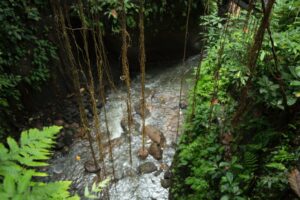Physical Address
23,24,25 & 26, 2nd Floor, Software Technology Park India, Opp: Garware Stadium,MIDC, Chikalthana, Aurangabad, Maharashtra – 431001 India
Physical Address
23,24,25 & 26, 2nd Floor, Software Technology Park India, Opp: Garware Stadium,MIDC, Chikalthana, Aurangabad, Maharashtra – 431001 India

By Aayushi Sharma
Climate change poses significant challenges to forest ecosystems, which play a vital role in regulating the Earth’s climate and supporting biodiversity. The Amazon rainforest, often referred to as the “lungs of the Earth,” is the largest tropical rainforest in the world, spanning nine countries in South America. It is home to an incredibly diverse array of plant and animal species, many of which are found nowhere else on Earth.
Here are 5 ways in which Climate Change is affecting the Amazon rainforest:
1. Increased severity and frequency of wildfires:
In earlier times, untouched rainforests maintained a consistent level of moisture year-round, rendering them naturally resilient to fires. However, the onset of climate change has introduced a new challenge. Rising temperatures and shifting weather patterns have created drier conditions, diminishing the forest’s innate ability to withstand fires. This transformation in environmental dynamics presents significant hurdles in the management and containment of wildfires within these pristine ecosystems.
Traditionally, the lushness and humidity of undisturbed rainforests acted as a barrier against widespread fire outbreaks. Yet, with the advent of climate change-induced alterations, such protective mechanisms are increasingly compromised. The elevated temperatures and reduced moisture levels not only intensify the frequency and severity of wildfires but also render them more challenging to suppress and control.
On 22 August 2022, 3,358 fires were detected in the Brazilian Amazon, as reported by the Brazilian space agency, INPE. This set the record for the highest number of fires for any 24-hour period since 2007.
2. Loss of Biodiversity:
From towering canopy trees to a wide range of jungle cats, the Amazon is filled with life at every level of the ecosystem.
Plant diversity in the Amazon is particularly remarkable, with an estimated 16,000 tree species alone. These trees support a vast web of life, providing habitat and sustenance for countless organisms. The rainforest also hosts an incredible variety of wildlife, including iconic species like jaguars, sloths, macaws, and anacondas, as well as countless insects, amphibians, and fish.
Biodiversity loss in the Amazon rainforest is a pressing concern with far-reaching implications. As one of the most biologically diverse regions on Earth, the Amazon is home to millions of plant and animal species, many of which are found nowhere else. However, factors such as deforestation, habitat fragmentation, illegal logging, and climate change are rapidly degrading this invaluable ecosystem.
The loss of biodiversity in the Amazon not only threatens the survival of countless species but also undermines essential ecosystem services like carbon sequestration, climate regulation, and water cycling. Furthermore, indigenous communities who depend on the forest for their livelihoods and cultural identity are disproportionately affected.
3. Droughts due to change in precipitation pattern:
Examining weather records-based datasets reveals the exceptional nature of the drought, even in today’s climate. Meteorological drought, characterized by the Standardized Precipitation Index (SPI), is deemed a 1 in 100 year event, while the Agricultural Standardized Precipitation Evapotranspiration Index (SPEI) designates it as approximately a 1 in 50 year event. The data points to a robust drying trend in meteorological drought, but agricultural drought exhibits an even more pronounced trend, suggesting that this level of agricultural drought would have been exceedingly rare in a cooler climate.
4. Increase in global temperature
Global warming has profound implications for the Amazon rainforest, manifesting in diverse and significant manners. The escalating temperatures and alterations in precipitation regimes disturb the intricate equilibrium of the ecosystem, fostering heightened occurrences of droughts, wildfires, and alterations in species distributions. These climatic shifts pose formidable challenges to the Amazon’s resilience and long-term viability.
Moreover, deforestation, primarily propelled by human endeavors, compounds these adverse impacts, posing a grave threat to the Amazon’s biodiversity and overall ecological well-being. The loss of forest cover exacerbates the region’s vulnerability to the impacts of global warming, amplifying the frequency and intensity of natural disasters such as fires and exacerbating habitat fragmentation for countless species.
Collectively, these multifaceted pressures underscore the urgent need for concerted global efforts to mitigate climate change, preserve critical ecosystems, and promote sustainable practices that safeguard the Amazon rainforest and its invaluable biodiversity for future generations.
5. Feedback loops:
The Amazon rainforest is a vital component of Earth’s climate regulation, serving as a significant carbon sink by absorbing carbon dioxide and releasing oxygen through photosynthesis. However, climate change is disturbing this delicate balance. Factors such as deforestation, droughts, and wildfires are compromising the Amazon’s ability to sequester carbon effectively. As trees are cleared, droughts become more frequent, and wildfires intensify, the rainforest’s capacity to absorb carbon dioxide diminishes. This reduction in the Amazon’s carbon storage capabilities contributes to higher levels of carbon dioxide in the atmosphere, exacerbating global warming. Consequently, the warming climate further stresses the Amazon, creating a feedback loop of escalating environmental degradation. Addressing these challenges requires urgent action to curb deforestation, mitigate climate change impacts, and support sustainable land management practices.
Protecting the Amazon’s role as a carbon sink is crucial not only for the health of the rainforest itself but also for stabilizing the Earth’s climate and safeguarding biodiversity on a global scale.
References:
Banner Image:
https://www.pexels.com/photo/photography-of-river-with-rocks-819373/
Images:
Photo by Dominiquemel16 Ramos
https://www.pexels.com/photo/close-up-shot-of-hyacinth-macaw-12590274/
Comments are closed.
I just could not depart your web site prior to suggesting that I really loved the usual info an individual supply in your visitors Is gonna be back regularly to check up on new posts